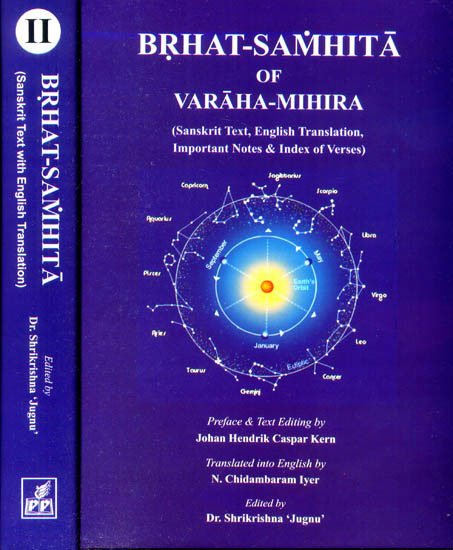Brihat Samhita
by N. Chidambaram Iyer | 1884 | 135,584 words | ISBN-13: 9788171104215
This page describes rubies (padmaraga-lakshana) which is the eighty-second Chapter of the English translation of the Brihat-samhita. This work, written by Varahamihira in the 6th century, is classified as jyotisha literature, also known as Indian astronomy. It contains however, also content regarding astrology, palmistry, agriculture, gardening, perfumes, medicines and various other encyclopedic topics.
Chapter 82 - On Rubies (padmarāga-lakṣaṇa)
[Sanskrit text for this chapter is available]
1. Rubies (padmarāga) are formed from Saugandhika, from Kuruvinda, and from crystals. The Saungandhika rubi es are of the colour of the bee, collyrium, clouds or the fruit of the rose-apple, and are glossy.
2. The Kuruvinda rubies are of the colour of the mixture of black and white, somewhat bright and mixed with minerals, and the crystalline rubies are bright, pure and of different colours.
3. Rubies of superior quality are bright, glossy, pure, red, and rendering red objects around, dazzling, heavy, well-shaped and of good water.
4. Gems that are dim, slightly bright, glossy, with lines, mixed with minerals or with gravel, or broken are not good ones. These are the faults of gems.
5. A gem of the colour of the bee, the neck of the peacock or the tip of flame, if found in the head of a serpent. It has no value.
6. A king who wears such a gem will never suffer from the attacks of poison and disease. There will be rainfall in his country every day in the year and the king’s enemies will meet with ruin—all this through the virtues of the gem.
7. The price of a ruby (padmarāga) weighing a Pala is 26,000 Kārṣāpaṇas, and the price of a ruby weighing three Karṣas[1] [¾ of a pala] is 20,000 Kārṣāpaṇas.
8. If the weight be two Karṣas (½ Pala) the price is 12,000 Kārṣāpaṇas; if the weight be a Karṣa, the price is 6,000 Kārṣāpaṇas, and if the weight be 8 Māṣas, the price is 3,000 Kārṣāpaṇas.
9. If the weight be 4 Māṣas, the price is 1,000 Kārṣāpaṇas, and if it be 2 Māṣas, the price is 500 Kārṣāpaṇas. For rubies of intermediate weight, the price shall be ascertained by proportion. The price of rubies which fall a little short of being superior rubies is as follows:
10. If the fault be a defect in colour, the price shall be reduced to one-half; if the gem be not bright and glossy, the price shall be reduced to one-eighth, and if the gem possess very few good qualities but many faults, the price shall be reduced to one-twentieth.
11. If the gem be wholly red black and full of wounds and if the good qualities be very few, the price shall be reduced to a two-hundredth part. Thus has been described the valuation of rubies (padmarāga) by the ancient writers.
Footnotes and references:
[1]:
16 Māṣas = 1 Karṣa.
4 KArṣas = 1 Pala.
